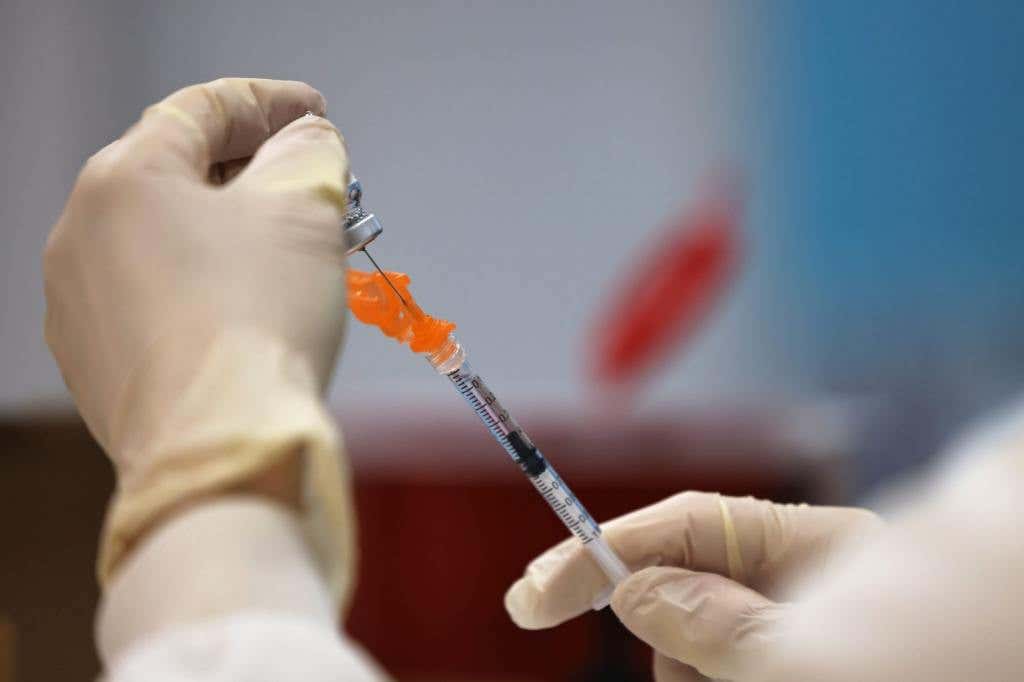
A Northwell Health medical staff member prepares a dose of the Johnson & Johnson coronavirus (COVID-19) at the Northwell Health pop-up coronavirus (COVID-19) vaccination site at the Albanian Islamic Cultural Center in Staten Island on April 08, 2021 in New York City. NYC continues to have a 6.55 percent coronavirus (COVID-19) cases on a seven-day rolling average as the city continues to ramp up vaccinations. The city last week set a record of 524,520 coronavirus (COVID-19) vaccinations.
Michael M. Santiago/Getty ImagesDespite the nationwide pause on administering Johnson & Johnson vaccines after reports of six women experienced a rare blood clotting reaction, federal officials said people who got the J&J shot in the last few weeks shouldn’t be nervous.
They should keep an eye out for possible warning signs though, NBC News reports. For individuals who got the Johnson & Johnson vaccine more than a month ago and are not experiencing any symptoms, there is little reason to feel anxious, Dr. Anthony Fauci, director of the National Institute of Allergy and Infectious Diseases, said during a White House briefing. Any serious reaction would have been evident by now.
For those who received the Johnson & Johnson shot within the last few weeks, it’s important to be alert for symptoms.
The symptoms include: severe headache, abdominal pain, leg pain and shortness of breath.
Fauci said, “First of all, don't get an anxiety reaction, because remember it's less than one in a million. However, having said that, pay attention.” Other possible symptoms include chest discomfort or neurological signs, which can include visual changes.
People who have received the shot recently experiencing any of the aforementioned symptoms should contact their health care provider, officials said. “If someone ends up with a very severe headache or any type of shortness of breath, pain in their leg, or severe pain in their abdomen, they would want to seek medical attention,” said Dr. Peter Marks, director of the FDA's Center for Biologics Evaluation and Research.
Dr. Anne Schuchat, principal deputy director of the CDC, said the risk levels of people who got the vaccine more than a month ago, "is very low at this time."
All six cases that experienced blood clots were women between the ages of 18 and 48 and all of them developed the illness within one to three weeks of vaccination. One woman died and a second woman has been hospitalized in critical condition.
In the CDC and FDA’s joint statement, they note that “As of April 12, more than 6.8 million doses of the Johnson & Johnson vaccine have been administered in the U.S.” Adding that, “Right now, these adverse events appear to be extremely rare.” Indeed, it is a less than 1 in 1 million occurrence.
According to FDA and CDC officials, health care providers need to be aware that treatment for this specific type of blood clot is different from what's frequently used for blood clots.
Schuchat said, “We're not seeing clotting events with low platelet counts with the other two vaccines. People who have vaccine appointments with the other two vaccines should continue with their appointments.” At this time, there are no reports of the condition linked to the mRNA vaccines from Pfizer-BioNTech and Moderna. There have been more than 180 million doses of the mRNA vaccines administered in the U.S. since December.




